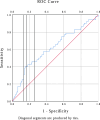Endometrial Thickness Change in Response to Progesterone is Associated with Ongoing Pregnancy Rate in Women with Treated Intrauterine Adhesion - A Prospective Cohort Study
- PMID: 40386085
- PMCID: PMC12085123
- DOI: 10.2147/IJWH.S521115
Endometrial Thickness Change in Response to Progesterone is Associated with Ongoing Pregnancy Rate in Women with Treated Intrauterine Adhesion - A Prospective Cohort Study
Abstract
Objective: This study aimed to investigate whether endometrial thickness (EmT) change prognosticates the ongoing pregnancy rate (OPR) in hormonally prepared frozen-thawed embryo transfers (FETs) in women with treated intrauterine adhesion (IUA).
Methods: We prospectively examined 261 FET cycles in women with IUA. Ultimately, 156 patients were included in the final analysis. The primary outcome was OPR. The association between the EmT change ratio and OPR, as well as the relationship between the EmT change and serum hormone concentration, was analyzed.
Results: The intraclass correlation coefficient for repeated EmT measurements was 0.944 (95% CI: 0.933-0.954, P < 0.001). Subdividing by the expansion cutoff from 5% to 15%, the 10% expansion group had the highest OPR with optimal sensitivity and specificity. Regarding the baseline characteristics, there were no statistically significant differences between the two groups. Nevertheless, the OPR increased significantly in cycles with endometrial expansion ≥ 10% compared to those with no expansion (55.3% vs 26.3%, P=0.001). The difference was still significant after adjustment between the two groups (adjusted OR, 3.74; 95% CI 1.68-8.34, P=0.001). No correlation was found between the EmT change and serum hormone concentrations.
Conclusion: Endometrial expansion was significantly correlated with higher OPR in women with treated IUA in the hormonal protocol for FET.
Keywords: endometrial thickness; frozen embryo transfer; intrauterine adhesion; pregnancy outcomes; progesterone.
© 2025 Hou et al.
Conflict of interest statement
The authors report no conflicts of interest in this work.
Figures






Similar articles
-
Influence of Maternal Age on the Relationship Between Endometrial Thickness and Ongoing Pregnancy Rates in Frozen-Thawed Embryo Transfer Cycles: A Retrospective Analysis of 2,562 Cycles.Front Endocrinol (Lausanne). 2022 Apr 27;13:821753. doi: 10.3389/fendo.2022.821753. eCollection 2022. Front Endocrinol (Lausanne). 2022. PMID: 35586619 Free PMC article.
-
Low serum progesterone on the day of embryo transfer is associated with a diminished ongoing pregnancy rate in oocyte donation cycles after artificial endometrial preparation: a prospective study.Hum Reprod. 2017 Dec 1;32(12):2437-2442. doi: 10.1093/humrep/dex316. Hum Reprod. 2017. PMID: 29040638
-
Measuring the serum progesterone level on the day of transfer can be an additional tool to maximize ongoing pregnancies in single euploid frozen blastocyst transfers.Reprod Biol Endocrinol. 2019 Nov 29;17(1):102. doi: 10.1186/s12958-019-0549-9. Reprod Biol Endocrinol. 2019. PMID: 31783865 Free PMC article.
-
Association between proliferative-to-secretory endometrial compaction and pregnancy outcomes after embryo transfer: a systematic review and meta-analysis.Hum Reprod. 2024 Apr 3;39(4):749-759. doi: 10.1093/humrep/deae012. Hum Reprod. 2024. PMID: 38323525
-
Endometrial preparation for women undergoing embryo transfer with frozen embryos or embryos derived from donor oocytes.Cochrane Database Syst Rev. 2020 Oct 28;10(10):CD006359. doi: 10.1002/14651858.CD006359.pub3. Cochrane Database Syst Rev. 2020. PMID: 33112418 Free PMC article.
References
LinkOut - more resources
Full Text Sources

